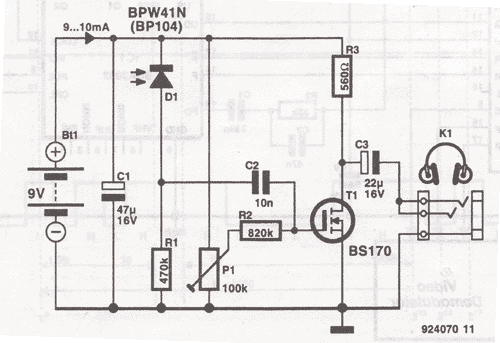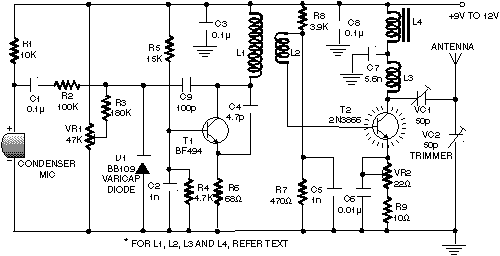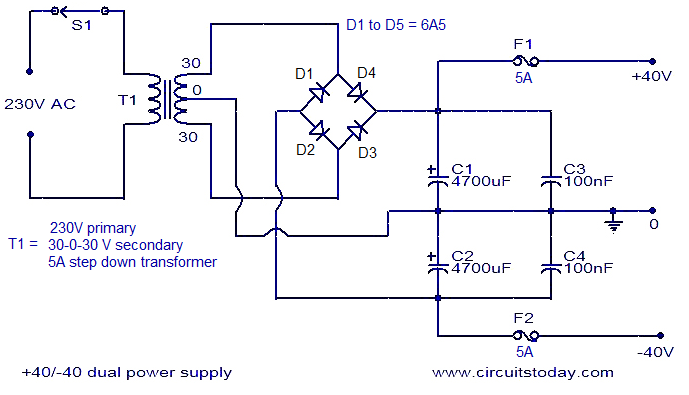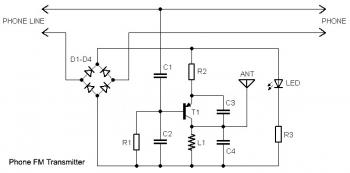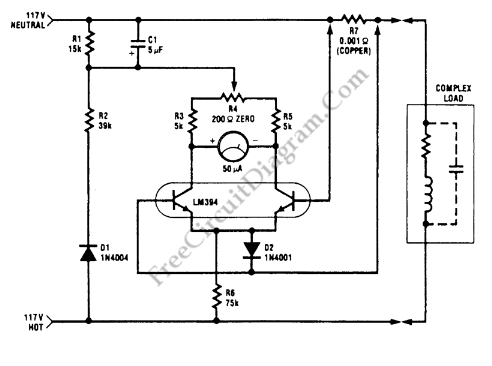
2 Watt FM Transmitter

The circuit functions as a radio frequency (RF) oscillator, operating around 100 MHz. Audio signals captured and amplified by an electret microphone are input into an audio amplifier stage constructed with the first transistor. The output from the collector of this transistor is directed to the base of a second transistor, where it modulates the resonant frequency of the tank circuit (comprising the L1 coil and a trim capacitor) by altering the junction capacitance of the transistor. This junction capacitance varies based on the potential difference applied to the base of transistor T2. The tank circuit is configured in a Hartley oscillator arrangement. P1 serves as the volume control for the condenser microphone. For frequency modulation (FM), the coil should be small, constructed from thin gauge enamel magnet wire, with a diameter of a few millimeters. An ink tube from a pen can be used as a form for the coil, with 8 to 12 turns recommended. Small inductance coils introduce a degree of uncertainty in the tuning process.
The described circuit is a classic example of an RF oscillator designed for FM transmission. The core of the circuit is the Hartley oscillator, which utilizes a tank circuit to generate oscillations at the desired frequency. The tank circuit consists of an inductor (L1) and a variable capacitor (trim cap), which together determine the oscillation frequency. The modulation process is achieved via the second transistor (T2), which acts as a variable capacitor due to its junction capacitance. By applying audio signals from the electret microphone through the first transistor's amplifier stage, the audio signal modulates the frequency of the oscillator.
The choice of using an electret microphone is significant because it provides a compact and efficient means of capturing audio signals. The use of P1 as a volume control allows for user adjustment of the microphone's sensitivity, enabling better audio input levels for modulation.
Construction of the coil is critical for achieving the desired RF performance. The recommended use of a thin gauge enamel magnet wire ensures that the inductance remains small and manageable, which is essential for higher frequency applications. The specified method of forming the coil around an ink tube allows for consistent coil geometry, which is crucial in minimizing inductance variability. The number of turns, typically between 8 to 12, directly affects the inductance and thus the tuning characteristics of the oscillator.
Overall, this circuit design presents a straightforward approach to building a compact RF oscillator for FM applications, suitable for various experimental and educational purposes. Proper attention to component selection and construction techniques will enhance the performance and reliability of the oscillator.The circuit is basically a radio frequency (RF) oscillator that operates around 100 MHz. Audio picked up and amplified by the electret microphone is fed into the audio amplifier stage built around the first transistor. Output from the collector is fed into the base of the second transistor where it modulates the resonant frequency of the tank circ
uit (L1 coil and the trimcap) by varying the junction capacitance of the transistor. Junction capacitance is a function of the potential difference applied to the base of the transistor T2. The tank circuit is connected in a Hartley oscillator circuit. P1 act as condenser microphone volume level. For FM, coil will be small. Use thin gauge enamel magnet wire. the diameter of coil will be a couple mm: use ink tube from pen to form, and try 8-12 turns. Small inductance coils make for much guess work. 🔗 External reference
The described circuit is a classic example of an RF oscillator designed for FM transmission. The core of the circuit is the Hartley oscillator, which utilizes a tank circuit to generate oscillations at the desired frequency. The tank circuit consists of an inductor (L1) and a variable capacitor (trim cap), which together determine the oscillation frequency. The modulation process is achieved via the second transistor (T2), which acts as a variable capacitor due to its junction capacitance. By applying audio signals from the electret microphone through the first transistor's amplifier stage, the audio signal modulates the frequency of the oscillator.
The choice of using an electret microphone is significant because it provides a compact and efficient means of capturing audio signals. The use of P1 as a volume control allows for user adjustment of the microphone's sensitivity, enabling better audio input levels for modulation.
Construction of the coil is critical for achieving the desired RF performance. The recommended use of a thin gauge enamel magnet wire ensures that the inductance remains small and manageable, which is essential for higher frequency applications. The specified method of forming the coil around an ink tube allows for consistent coil geometry, which is crucial in minimizing inductance variability. The number of turns, typically between 8 to 12, directly affects the inductance and thus the tuning characteristics of the oscillator.
Overall, this circuit design presents a straightforward approach to building a compact RF oscillator for FM applications, suitable for various experimental and educational purposes. Proper attention to component selection and construction techniques will enhance the performance and reliability of the oscillator.The circuit is basically a radio frequency (RF) oscillator that operates around 100 MHz. Audio picked up and amplified by the electret microphone is fed into the audio amplifier stage built around the first transistor. Output from the collector is fed into the base of the second transistor where it modulates the resonant frequency of the tank circ
uit (L1 coil and the trimcap) by varying the junction capacitance of the transistor. Junction capacitance is a function of the potential difference applied to the base of the transistor T2. The tank circuit is connected in a Hartley oscillator circuit. P1 act as condenser microphone volume level. For FM, coil will be small. Use thin gauge enamel magnet wire. the diameter of coil will be a couple mm: use ink tube from pen to form, and try 8-12 turns. Small inductance coils make for much guess work. 🔗 External reference
